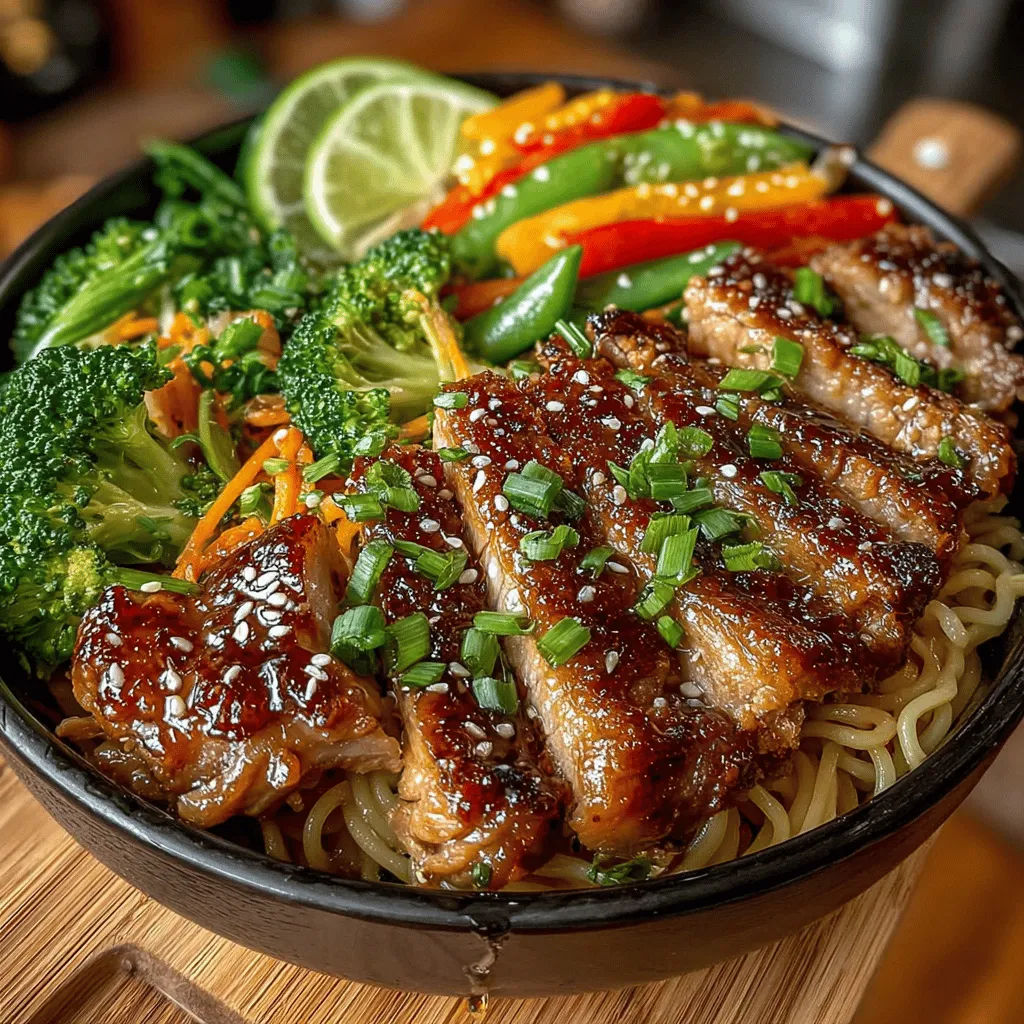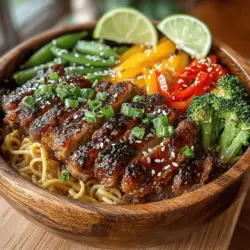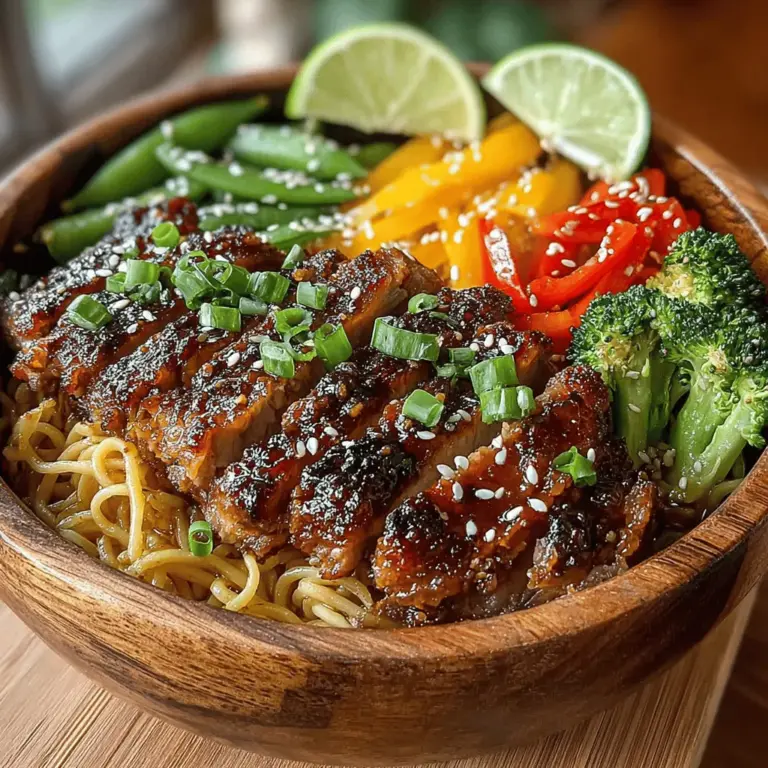Introduction to Sweet and Savory Sticky Teriyaki Chicken Noodle Bowls
In the culinary landscape, few dishes can claim the title of being both quick and utterly delicious as effectively as Sweet and Savory Sticky Teriyaki Chicken Noodle Bowls. This recipe represents a harmonious blend of tender, marinated chicken thighs, perfectly cooked noodles, and a vibrant array of vegetables, resulting in a meal that is as visually appealing as it is flavorful. The balance of sweet and savory elements in this dish creates an explosion of taste that is sure to please a variety of palates, making it a fantastic choice for anything from a cozy weeknight dinner to an impressive dish for entertaining guests.
Originating from Japan, teriyaki sauce has become a beloved staple in many kitchens worldwide. Its name translates to “glaze” (teri) and “grill” (yaki), referring to the cooking method traditionally used. However, this dish takes a modern twist with the addition of fresh ingredients and a variety of textures, ensuring that each bite is delightful. The sticky nature of the sauce enveloping the chicken and noodles not only enhances the flavor but also makes for an enticing presentation. As we delve into the preparation of this dish, you’ll discover how straightforward it is to create a meal that feels indulgent while still being nutritious.
Understanding the Key Ingredients
To fully appreciate the depth of flavor and texture in Sweet and Savory Sticky Teriyaki Chicken Noodle Bowls, it’s crucial to understand the key ingredients that come together to create this dish.
The Teriyaki Chicken
– Chicken Thighs: While some may opt for chicken breasts, boneless, skinless thighs are the ideal choice for this recipe. The thighs offer a greater richness and moisture content, ensuring that the meat remains juicy even after cooking. This fat content also means that the chicken absorbs the teriyaki marinade more effectively, leading to a more pronounced flavor.
– Soy Sauce: As the backbone of teriyaki flavor, soy sauce is essential in this recipe. It provides the salty component that balances the sweetness of the sauce. For those looking for a gluten-free option, tamari can be used as a substitute without losing any of the dish’s signature taste.
– Brown Sugar and Honey: These two ingredients work in tandem to create the sweet element of the teriyaki sauce. Brown sugar, with its molasses content, adds a depth of flavor, while honey contributes a floral sweetness. Together, they create a sticky, caramelized glaze that clings to the chicken and noodles.
– Rice Vinegar: This ingredient is not just a tangy addition; it serves to brighten the overall flavor of the dish. The acidity of rice vinegar cuts through the sweetness, providing a balanced taste that enhances the other ingredients.
– Garlic and Ginger: These aromatics are key to elevating the flavor profile of the teriyaki sauce. Fresh ginger adds warmth and a slight spiciness, while garlic contributes a savory depth. Together, they create a robust foundation for the dish.
The Noodle Bowl
– Noodles: Choosing the right noodle is crucial for achieving the perfect noodle bowl. Rice noodles or soba noodles are excellent options. Rice noodles are gluten-free and have a delicate texture that absorbs the sauce well, while soba noodles offer a nutty flavor and additional protein due to their buckwheat content.
– Vegetables: The addition of colorful vegetables not only enhances the nutritional value of the dish but also adds crunch and freshness. Broccoli provides fiber and vitamins, bell peppers add sweetness and color, carrots introduce a satisfying crunch, and snap peas offer a delightful snap, making each bite interesting.
– Garnishes: Finally, garnishes like sliced green onions, sesame seeds, and lime wedges play an essential role in the dish. Green onions add a fresh, slightly spicy note, sesame seeds provide a nutty crunch, and lime wedges introduce a zesty acidity that brightens the entire bowl.
Preparing the Teriyaki Chicken
With a solid understanding of the ingredients, the next step is to focus on preparing the teriyaki chicken, which is the star of this dish.
Marinating for Maximum Flavor
To create the perfect marinade, combine soy sauce, brown sugar, rice vinegar, honey, minced garlic, and grated ginger in a bowl. Whisk these ingredients together until the sugar is fully dissolved, creating a glossy sauce that promises a rich flavor. The marinating process is crucial; for optimal flavor absorption, allow the chicken thighs to marinate for at least 30 minutes, though a few hours or even overnight will yield even better results. This time allows the flavors to penetrate the meat, resulting in a more delicious and aromatic dish.
Cooking Techniques
Once marinated, it’s time to cook the chicken. Pan-searing is an ideal method for achieving a golden-brown crust while keeping the inside juicy. Start by heating a tablespoon of oil in a large skillet over medium-high heat. Place the marinated chicken thighs in the skillet, ensuring they are not overcrowded. Sear for about 5-7 minutes on each side, or until a beautiful golden crust forms. For food safety, it’s essential to ensure that the internal temperature of the chicken reaches 165°F (75°C). Using a meat thermometer will help guarantee that your chicken is cooked perfectly, avoiding any risk of undercooking.
Creating the Noodle Bowl
As the chicken cooks, it’s time to prepare the noodles. Begin by bringing a large pot of water to a boil, then add your choice of noodles. Follow the package instructions for cooking times, which typically range from 4 to 8 minutes, depending on the type of noodles you choose. For rice noodles, it’s important to watch them closely, as they can become mushy if overcooked. Once cooked, drain the noodles and rinse them under cold water to stop the cooking process and prevent sticking.
Once the chicken is finished cooking and the noodles are perfectly al dente, you can begin assembling your Sweet and Savory Sticky Teriyaki Chicken Noodle Bowls.
In this first part of the article, we’ve laid the groundwork for creating a delicious and satisfying dish that marries the flavors of teriyaki chicken with a variety of wholesome ingredients. The process may seem intricate, but with careful attention to detail, anyone can master this flavorful recipe.

Cooking the Noodles
Step-by-Step Instructions on How to Cook Rice Noodles or Soba Noodles
Cooking noodles is a simple yet crucial part of making your Sweet and Savory Sticky Teriyaki Chicken Noodle Bowls. Here’s how to prepare either rice noodles or soba noodles perfectly:
1. Preparation: Begin by reading the package instructions as cooking times can vary between brands and types. For rice noodles, soak them in warm water for 20-30 minutes until they soften. For soba noodles, you’ll need to boil them.
2. Cooking Rice Noodles:
– Bring a large pot of water to a rolling boil.
– Add the soaked rice noodles to the boiling water and cook for about 3-5 minutes, or until they are tender but still slightly chewy (al dente).
– Drain the noodles in a colander and rinse them under cold water to stop the cooking process. This also helps remove excess starch.
3. Cooking Soba Noodles:
– Bring a pot of water to a boil, then add the soba noodles.
– Cook for about 4-6 minutes, again checking for al dente texture.
– Drain and rinse under cold water to prevent sticking.
4. Finishing Touches: After rinsing, you can toss the noodles with a drizzle of sesame oil to add flavor and ensure they don’t stick together.
Tips for Preventing Noodles from Sticking Together
– Rinse Thoroughly: Always rinse your noodles after cooking to remove excess starch.
– Use Oil: A small splash of oil, such as sesame or olive oil, can create a barrier and prevent the noodles from clumping.
– Toss Gently: When mixing the noodles with other ingredients, use a gentle hand to avoid breaking them and encourage even distribution.
Stir-Frying the Vegetables
The Importance of High Heat: How to Achieve the Perfect Stir-Fried Texture
Stir-frying is an art, and using high heat is essential for achieving that signature wok hei— the charred aroma that elevates the dish. Here’s how to do it effectively:
1. Preheat the Pan: Heat a large skillet or wok over medium-high heat until it’s hot. You can test the heat by sprinkling a few drops of water; if they sizzle and evaporate immediately, the pan is ready.
2. Add Oil: Use a high smoke point oil, such as canola or peanut oil. Add a tablespoon to the hot pan, swirling it around to coat the surface evenly.
3. Add Vegetables: Introduce your prepared vegetables (bell peppers, broccoli, carrots, etc.) to the pan in batches. This prevents overcrowding and ensures they fry rather than steam. Stir-fry for 2-3 minutes until slightly charred and crisp.
Timing Your Vegetables: Ensuring They Maintain Their Crispness
To maintain the crunchiness of your vegetables, timing is crucial:
– Cook in Order: Start with denser vegetables like carrots and broccoli, which take longer to cook. Add quicker-cooking veggies like bell peppers and snap peas later in the stir-frying process.
– Visual Cues: Look for bright colors and a slight char on the vegetables. They should be tender yet firm to the bite, embodying that fresh crunch.
Crafting the Sticky Sauce
Bringing It All Together
Using the Leftover Marinade: Transforming It Into a Sticky Sauce
The leftover marinade is a goldmine for flavor. Here’s how to transform it into a delicious sticky sauce:
1. Heat the Marinade: In the same pan used for stir-frying, pour the leftover marinade over medium heat.
2. Simmer: Allow it to simmer for about 2-3 minutes to cook off any raw chicken juices, ensuring food safety.
3. Flavor Enhancement: You can add a splash of soy sauce or a pinch of brown sugar for extra depth.
The Thickening Process: How Cornstarch Creates a Glossy Finish
To achieve that glossy, sticky texture:
1. Make a Slurry: In a small bowl, mix 1 tablespoon of cornstarch with 2 tablespoons of cold water until smooth.
2. Incorporate into Sauce: Slowly stir the cornstarch slurry into the simmering marinade. Continue to stir until the sauce thickens to a glossy consistency, which usually takes 1-2 minutes.
Assembling the Bowl
Combining the Ingredients
Mixing Noodles with Stir-Fried Vegetables
1. Add the Noodles: Once the sticky sauce has thickened, add the cooked noodles to the pan along with the stir-fried vegetables.
2. Toss Gently: Using tongs or a spatula, toss everything together until the noodles and vegetables are evenly coated with the sauce.
Arranging the Sliced Teriyaki Chicken on Top for Visual Appeal
1. Slice the Chicken: Take your marinated and cooked teriyaki chicken and slice it into thin strips.
2. Plate Beautifully: Serve the noodle and vegetable mixture in large bowls, placing the sliced chicken on top. This not only looks appealing but also allows everyone to see the delicious layers of the dish.
Serving Suggestions and Presentation
Creating an Inviting Dish
Tips on Plating for an Attractive Presentation
– Use Deep Bowls: Opt for deep bowls that can hold the noodles and toppings while allowing for a visually appealing presentation.
– Layering: Start with a base of noodles, then add vegetables and chicken on top. This layering showcases the dish’s components beautifully.
Discussing the Importance of Garnishes in Enhancing Both Aesthetics and Taste
Garnishes play a key role in both flavor and presentation. Consider:
– Fresh Herbs: Chopped green onions or cilantro add a pop of color and freshness.
– Sesame Seeds: Toasted sesame seeds provide a nutty flavor and crunch.
– Lime Wedges: A squeeze of lime just before eating can brighten the flavors and enhance the overall dish.
Nutrition Breakdown of the Dish
Understanding the Health Benefits
Caloric Content and Serving Size
This dish can easily fit into a balanced diet. A typical serving of Sweet and Savory Sticky Teriyaki Chicken Noodle Bowls contains approximately 450-500 calories, depending on the portion size and specific ingredients used.
Nutritional Benefits of the Ingredients
– Chicken: A great source of lean protein, which is essential for muscle repair and growth.
– Vegetables: Packed with vitamins, minerals, and antioxidants, they contribute to overall health and well-being. For instance, bell peppers are high in Vitamin C, while broccoli offers fiber and essential nutrients.
– Noodles: Depending on your choice, rice or soba noodles provide carbohydrates for energy and can be a source of B vitamins.
Conclusion: Enjoying Your Sweet and Savory Sticky Teriyaki Chicken Noodle Bowls
Sweet and Savory Sticky Teriyaki Chicken Noodle Bowls offer a delightful balance of flavors and nutrients that make them a fantastic choice for any meal. With simple ingredients and straightforward instructions, this dish can easily become a favorite in your household.
The combination of marinated chicken, fresh vegetables, and tender noodles creates a satisfying experience that is both comforting and wholesome. Whether enjoyed solo or shared with loved ones, this recipe is sure to bring joy to your dining table. Don’t hesitate to customize the vegetables or protein to suit your tastes, making this dish versatile and accommodating for all dietary preferences. Enjoy every bite of your flavorful creation, and relish the compliments that will surely come your way!


